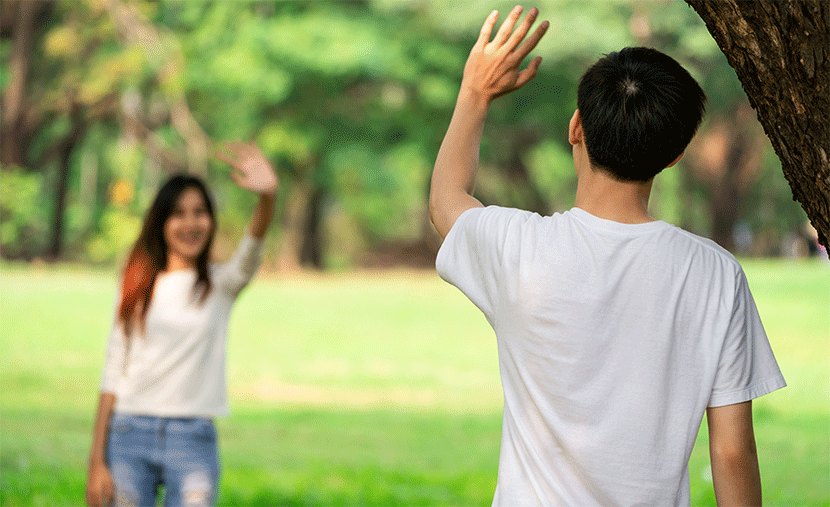Blog
Why the term ‘social distancing’ is problematic – and how to embrace social connection
With everything that’s going on in the world, it’s more crucial than ever to connect, converse and ‘click’ with others. But with the so-called ‘social distancing’ measures in place, how do we stay social?
Social distancing needs a rebrand
We’ve been told the best way to slow the spread of COVID-19 is through ‘social distancing’.
However, this expression can make us feel limited – particularly during this time of great uncertainty. It suggests we not only stay away from each other physically, but also isolate ourselves socially. And that’s just not the case.
In fact, at a time when our mental health and wellbeing are likely to be more fragile, social connection is more important than ever. And let’s not forget that emotions such as stress, anxiety and worry can be brought about because we can’t be near each other physically.
So while we may be taking physical measures to avoid contracting the virus, at what cost does this come to our mental health? There’s science to back it up too. In fact, caring for your mental health can also have a positive impact on your physical wellbeing.
Let’s use ‘physical distancing’ instead
By swapping in the term ‘physical distancing’, it tells us all that we can continue to be social, despite being in different rooms, houses or even countries!
The word ‘physical’ drives home that we’re referring to metric distancing, not our connection to the outside world – something that ‘social distancing’ may imply.
The World Health Organisation (WHO) and other health experts have started applying this term as well, demonstrating the importance of using labels which accurately reflect their meaning.
Or should we call it ‘social solidarity’?
Humans are innately social animals. That’s why during such extraordinary times, we need to practise social solidarity, not social distancing.
This means constructing our communities so that people help strangers and neighbours the same way they would friends and family. It means extending a helping hand to vulnerable people in the community. And when we extend kindness outwards, it can help us feel more socially connected, too.
It’s also a way of saying: ‘I know what you’re going through. I’m going through it too – and we’re all in this together’.
That logic leads us to a valuable takeaway from coronavirus (or any pandemic, for that matter): the widespread nature gives us something to bond over. And we can create humanity through likeness.
How about some social connecting guidelines?
Stay at home. Wash your hands. No gatherings of more than two people. We’re all aware of the physical distancing guidelines. But how about social connecting guidelines?
Here are some ideas to help get your social blood flowing again:
- Prioritise communication: Think about other communication methods you can use (beyond Skype or Zoom). For example, maybe you can have a chat with your next-door neighbour over the garden fence? Or take inspiration from Italy’s residents and play music into the street, sharing joy among the neighbourhood.
- Do ‘outside’ activities virtually: The new Netflix Party is like a trip to the cinema, allowing you to watch your favourite flicks with some good company. You could also try a virtual yoga class with some friends over video call. You’ll find yourself laughing over your sun salutation in no time!
- Practise gratitude: When sitting down at the dinner table with your family, or having a virtual catch-up with colleagues, it’s a good chance to express all the things you’re grateful for. (Try and avoid bringing up the things that you miss.) Maybe you feel lucky to have access to the technology that allows you to connect with those you’re not physically near. Or maybe its gratitude for healthcare workers doing their best to keep the community healthy. Remember: positivity breeds positivity.
- Revive traditional forms of communication: We don’t mean a tin can and a piece of string. (Although if you’re looking for a fun activity for the kids stuck at home, that’ll occupy them for hours.) Some of the older people in our lives may be having trouble using new technologies. To make sure they’re not left out, call them up on the phone (no video necessary!) – or write a good-old-fashioned letter and post it.
- Take off some pressure: Without realising it, you might be feeling a lot of pressure to spend quality time as a ‘family unit’. Yet it’s just as important to enjoy one-on-one relationships too. Carve out some time for just you and one other family member, or just you and someone not in your immediate family (virtually, of course). Having the whole household in on every affair can be overbearing, and you might find yourselves getting under each other’s skin more quickly.
It’s important to invest in and nurture our social relations when we’re physically distancing. If you or someone you know is struggling with mental health issues during these times, please get in touch. Our trained psychologists are here to help – and available for remote consultations. Call us on 1300 995 636.

